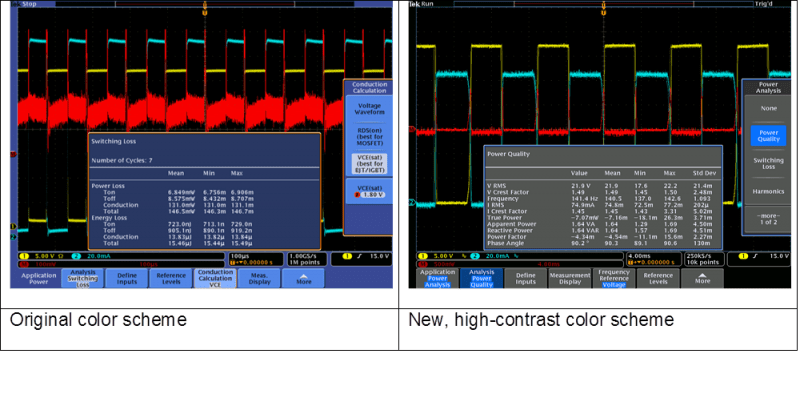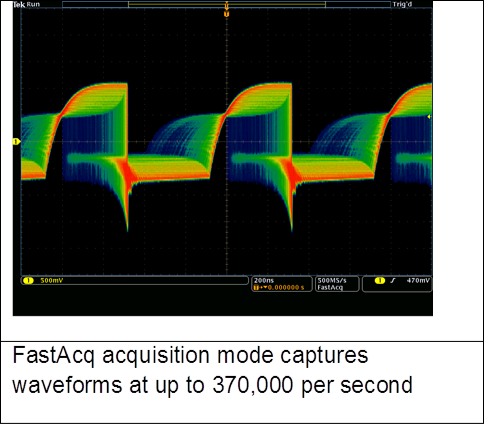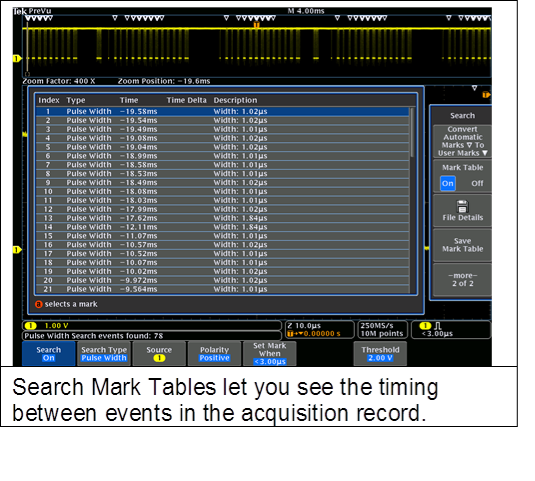

Most firmware updates come into the world without much fanfare. It’s hard to get excited about subtle changes or behind the scenes enhancements. On the other hand, sometimes a firmware update comes along that makes you feel like you’ve got a brand new instrument. The recently-released firmware for the MDO4000B and MSO/DPO4000B Series Oscilloscopes falls into this latter category. Any MDO/MSO/DPO4000B can be updated with this new firmware and it comes at a great price – free! In this blog entry I’ll share my favorite new features.
The first change you’ll notice after you install the new firmware is to the display. It gets a complete makeover. A new, higher-contrast color scheme makes it easier to see menu selections and measurements.

Installing the new firmware increases the waveform capture rate from a brisk rate of more than 50,000 waveforms per second to more than 340,000 waveforms per second on 1 GHz instruments. The capture rate increases to more than 270,000 on 100 MHz – 500 MHz instruments. This FastAcq™ high-speed waveform acquisition mode was previously only available on higher-end scopes.
These instruments already feature Digital Phosphor technology that “intensity-grades” waveforms based on how frequently characteristics of the waveform occur. The fast capture rate and intensity grading work together to help surface one-in-a-million anomalies. And now, with this new firmware release, color-grading has been added to make changes in intensity even easier to see. FastAcq is activated from the Acquire menu.

A new “Act-on-Event” capability makes the scope more useful for unattended monitoring. It lets you specify actions to take when a trigger occurs or when a defined number of acquisitions complete. Act-on-Event is set up through the Test menu. Available actions include:
- Stop acquisition
- Save waveform to file
- Save screen image
- Generate a Pulse on the AUX OUT
- Generate a remote interface service request
- Send an e-mail notification
- Post a visual indication on-screen
The automated search capability on these scopes has always been handy. In general, if you can describe a condition as a trigger, you can also use it as a search condition. The screen below shows a search for all pulses less than 3 µs wide. The new firmware provides a “search mark table” which gives a listing of all events found by an automated search. Each event is shown with a time stamp making timing measurements between events easy. The table data can be exported to a .csv file for additional analysis.

I get no joy from hooking up logic channels. It’s not that my fingers are fat, but my eyes aren’t great, so the chances of swapping channels or connecting to the wrong pins are pretty high. A new digital channel activity monitor lets you quickly see which of the 16 digital channels are transitioning, stuck high, or stuck low, as soon as you hook them up.

These are my favorites, but the new firmware also adds several other features worth mentioning:
- Dual edge trigger: Edge trigger can be set to trigger on a rising, falling, or either edge.
- E-print: E-mail printing to compatible printers through the network port.
- Display auto dim: Automatic dimming of the internal display to increase display life and reduce power consumption. The display will automatically dim when a user-defined time period has passed with no activity. Touching any control or button on the instrument will resume the display at the preset brightness level for use.
- Math autoscale on/off: New control in the Math menu that selects whether math waveforms are autoscaled or not.
- Network mounting of Mac hard drives on OS/X 10.7 and later: Support for time zone enables mounting of hard drives connected to Mac computers running OS/X v 10.7 or later.
- Video picture mode (requires DPO4VID): Display a picture of an NTSC/PAL video signal. Automatic or manual contrast and brightness controls along with odd, even, or interlaced field selection and control over the placement of the image on the display create a unique analog video troubleshooting environment.
The new firmware is available for download at www.tektronix.com.To download the firmware, put the model number of your instrument in the Downloads tool on the www.tektronix.com home page. You’ll find the latest firmware, along with installation instructions and a readme file. Be sure to let us know how you like the new features in the comments below.

Download “finder” on the lower right of the www.tektronix.com homepage.
Since publishing the above blog, Tektronix is currently offering a free upgrade to 3/6 GHz spectrum analyzers and a free bundle of software applications on mixed-domain oscilloscopes.


